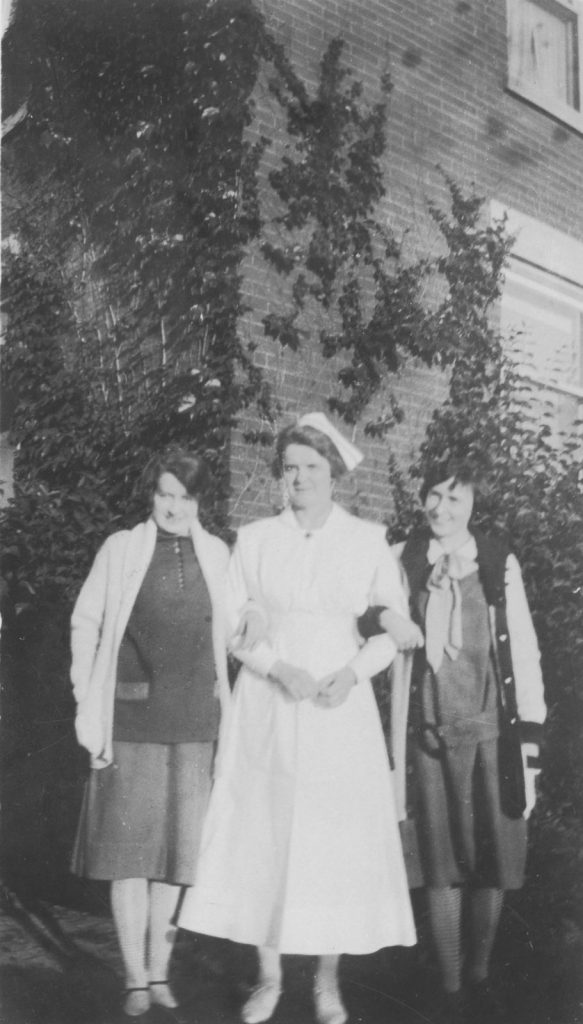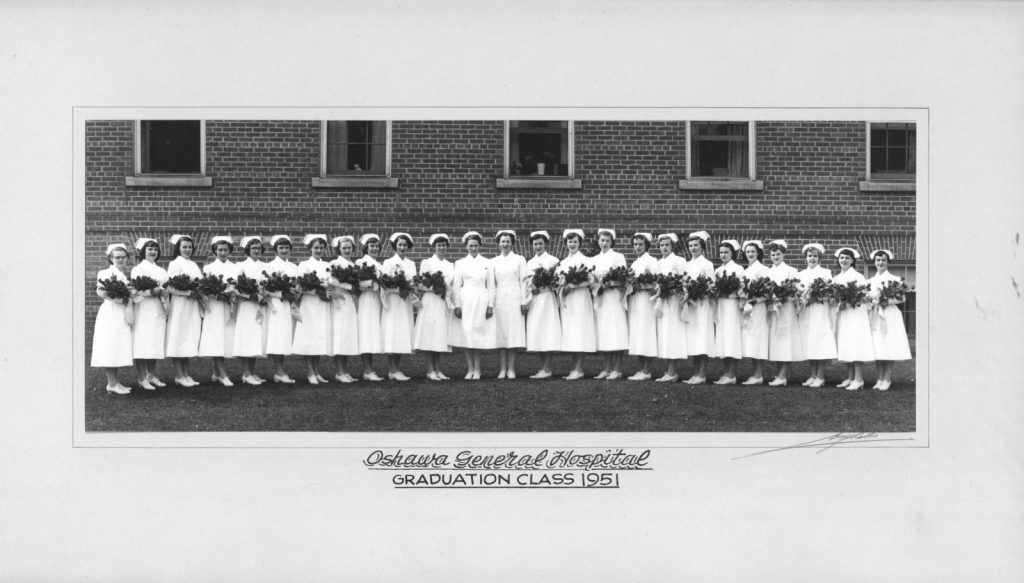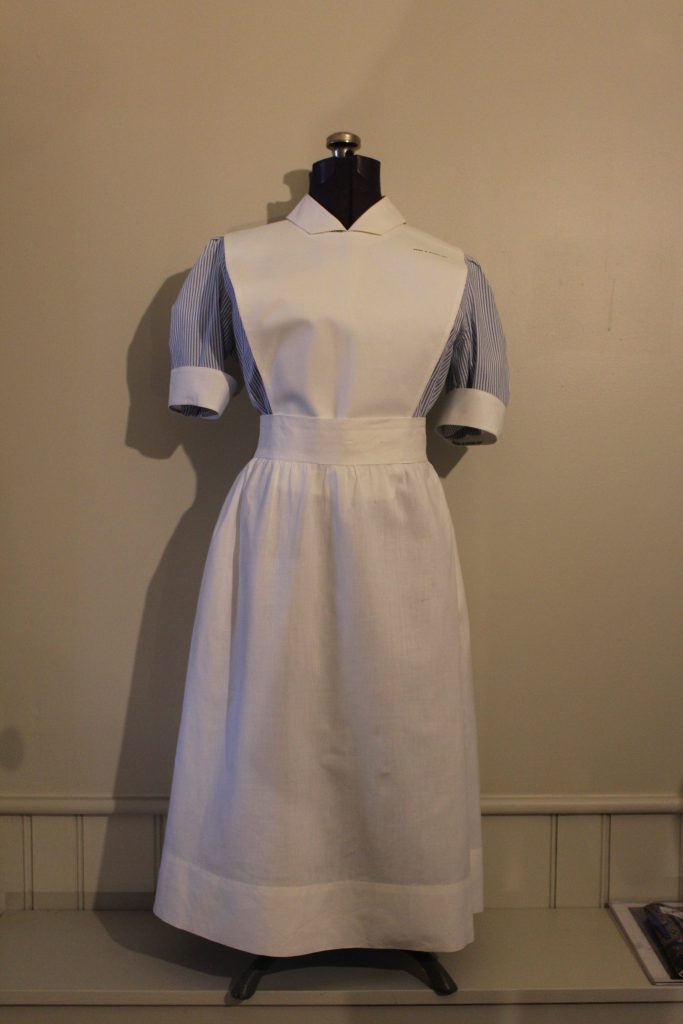A Profession of Care: A History of Oshawa General Hospital’s School of Nursing
During this global pandemic, nurses are needed more than ever. They are essential workers in our health care system whose courage and dedication should be celebrated during normal times, let alone in the midst of the current crisis. Created in partnership with the Oshawa Public Libraries and the Oshawa Museum, this exhibition looks back at Oshawa’s history of training nurses, through the Oshawa General Hospital School of Nursing, to salute healthcare workers everywhere and celebrate their exceptional skills.The Oshawa General Hospital School of Nursing was established shortly after the first hospital building opened in 1910.
During this time, hospital-based nursing schools were opening across Canada. Demand was high for new nurses and the brochures advertising the schools would specifically target young women, often outlining requirements for entry such as, “women of superior education and culture.”
The three-year program at Oshawa General Hospital had its first three graduates in 1913, with the graduation ceremony held at the Oshawa High School (today O’Neill Collegiate & Vocational Institute), a tradition that continued for many years. Life in the early years of the training program was arduous—twelve-hour shifts, seven days a week, with four hours of free time on Sundays. Since there were no tuition fees, students were expected to fully integrate into hospital life, supporting doctors and patients around the clock. Beginning with classroom training, students would then get hands-on experience working alongside doctors and nurses with patients from various departments such as maternity, surgical and pediatric.
The first students’ residence was composed of a few small rooms in the attic of the hospital. Later, a residence was built at 47 Alexandra Street that had a capacity to house forty nursing students. The school grew in the 1920s, which led to the need to fundraise for an addition to the residence. A campaign in 1922, led by the Women’s Auxiliary, raised $15,000 to build 10 more rooms.
In the 1940s, enrollment continued to increase, and the school was in desperate need of more space. Colonel and Mrs. R.S. McLaughlin donated the funds to build a new nurses’ residence. In November of 1947, McLaughlin Hall opened and was described as being among the finest of its kind in Canada. It was also during this period that new educational requirements for enrollment were established, including Secondary School Diploma credits in mathematics and sciences.More renovations were needed in the 1960s to further accommodate the growing school.
The basement of the Oshawa General Hospital, known as the “A Wing” became the new School of Nursing. In addition, the Minister of Health for Ontario changed all three-year nursing programs to two years in order to meet the demand for nursing professionals and began to experiment with standardized curriculum. Hospitals were reluctant to make changes to the programs as each hospital had individualized training programs, and were used to the reliable and inexpensive workers.
As healthcare technology advanced, nursing schools had to adapt. In 1973, the Ontario Government closed hospital-based nursing schools and shifted training to college or university-based programs. As a result of the changes, Oshawa General Hospital’s School of Nursing closed and the program was transferred to Durham College.
In its 60-year history, the Oshawa General Hospital School of Nursing had 1,198 graduates. Throughout the years, the school grew and evolved to keep up with the ever-changing healthcare system and contributed greatly to the community’s overall healthcare services. This exhibition celebrates our local history and is a small gesture to honour the incredible work our current healthcare workers do everyday.
Oshawa General Hospital, 1911
The Thomas Bouckley Collection

Oshawa General Hospital, 1911
The Thomas Bouckley Collection
Two nurses are seen on the front steps of the first Oshawa General McKay is standing beside an automobile owned by Dr. Rundle.
Oshawa General Hospital Staff, 1912
The Thomas Bouckley Collection

Oshawa General Hospital Staff, 1912
The Thomas Bouckley Collection
Photograph of the first Medical Board & Nursing Staff at the Oshawa General Hospital. All are identified.
Left to right, first card: Drs. Rundle, Hoig, Kaiser, Bolt, McKay
Second card: Drs. Ford, Finnigan, Walker, Carmichael
Third card: Nurses Drew, Selling, Scott, Oliver, Kett, MacWilliams (Lady Superintendent), Russell, Vernon, Cheesman
Oshawa General Hospital Nurses, 1912
The Thomas Bouckley Collection

Oshawa General Hospital Nurses, 1912
The Thomas Bouckley Collection
View of a group of nurses seated on the verandah at the Oshawa General Hospital. All are identified.
Back card, left to right: Misses Vernon, Drew, Scott, Oliver, Kett and Cheeseman.
Front card, left to right: Misses Vernon, McWilliams (Lady Superintendent), Seiling
What is a Student Nurse?
“Student nurses are to be found everywhere, underneath, on top of, running around, jumping over or slithering past patients’ beds…” – Unknown, 1963 Year Book
Student nurses are to be found everywhere, underneath, on top of, running around, jumping over or slithering past patients’ beds. Doctors overlook them, mothers worry about them and patients love them.
A student nurse is courage under a cap, a smile in snowy white, strength in starched skirts, energy that is endless, the best of young womanhood, a modern Florence Nightingale. Just when she is gaining poise and prestige, she drops a glass, breaks a syringe or steps on a doctor’s foot.
A student nurse is a composite. She eats like a team of hungry interns and works like the whole nursing staff put together. She has the speed of a gazelle, the strength of an ox, the quickness of a cat and the endurance of a flagpole sitter. To the head nurse she has the stability of mush, the fleetness of a snail, the mentality of a mule and is held together by starch, adhesive tape and strained nerves. To an alumnus, she will never work as hard, carry more trays, make more beds or scrub on more cases than her predecessors.
A student nurse likes days off, boys her own age, the O.R., affiliations, certain doctors, pretty clothes, her roommate and Mom and Dad. She is not much on working 3-11, days off with classes, alarm clocks, getting up for roll call or eating corned beef every Tuesday.
A student nurse is a wonderful creature. You can criticize her but you can’t make her quit. Might as well admit it, whether you are a head nurse, doctor, alumnus or patient, she is your personal representatives of the hospital, your living symbol of faith and sympathetic care.
Author Unknown, 1963 Year Book
Oshawa General Hospital Nursing Class of 1915
Collection of Oshawa Public Libraries, LH 2406

Oshawa General Hospital Nursing Class of 1915
Collection of Oshawa Public Libraries, LH 2406
The woman at the back, Miss MacWilliams, was the Lady Superintendent of Oshawa General Hospital for over ten years. She was in charge of the nurses-in-training program. In the Oshawa General Hospital: A Short History, it describes the position as: “The Lady Superintendent….shall have control, subject to the Board of Directors, of the Oshawa General Hospital and shall instruct Nurses or cause them to be instructed in the art of nursing.”
Oshawa General Hospital Nursing Class of 1925
Collection of Oshawa Public Libraries, LH 2888

Oshawa General Hospital Nursing Class of 1925
Collection of Oshawa Public Libraries, LH 2888
Miss MacWilliams, the Lady Superintendent of the Nursing School, stands on the right of the 1925 graduating class.
Maternity Ward, c. 1920
Collection of Oshawa Public Libraries, LH 2870

Maternity Ward, c. 1920
Collection of Oshawa Public Libraries, LH 2870
Group of nurses holding newborns in the maternity ward. The nurses in the training program received hands-on experience working in various departments of the hospital, including maternity and surgical.
Night Supervisor with Students, c. 1920
Collection of Oshawa Public Libraries, LH 2362

Night Supervisor with Students, c. 1920
Collection of Oshawa Public Libraries, LH 2362
Nurse Dryden (Night Supervisor) posing with two nursing students, Miss Shearer and Miss Drimmie, outside the hospital.
Students cutting surgical dressings, c. 1925-28
Collection of Oshawa Public Libraries, LH 2356

Students cutting surgical dressings, c. 1925-28
Collection of Oshawa Public Libraries, LH 2356
Two nursing students, Miss McCohn and Miss Hutchison, making dressings in the surgical wing of the hospital.
Off Duty Nursing Students, c. 1920
Collection of Oshawa Public Libraries, LH 2355

Off Duty Nursing Students, c. 1920
Collection of Oshawa Public Libraries, LH 2355
After coming off duty from the night shift, two nursing students, Miss Hinton and Miss Thompson, have some fun fooling around on the grandstand at Alexandra Park.
Nursing School Staff, 1928
Collection of Oshawa Public Libraries, LH 2357

Nursing School Staff, 1928
Collection of Oshawa Public Libraries, LH 2357
Nursing school staff, including Lady Superintendent Miss McWilliams (fourth from left) posing outside in formal gowns.
Nursing School Cafeteria, c. 1940
Collection of Oshawa Public Libraries, LH 2872

Nursing School Cafeteria, c. 1940
Collection of Oshawa Public Libraries, LH 2872
The nurses-in-training lived in residences on the hospital grounds. As the school grew, so did the need for most residence space. This cafeteria is believed to have been located in McLaughlin Hall, a state-of-the-art facility at the time.

By the 1950s, admission to the Nursing School had greatly increased. These graduates pose outside of Oshawa High School (today O’Neil Collegiate & Vocational Institute). The photograph was taken by Campbell’s Studio, based in Oshawa.
Collection of the Oshawa Public Libraries, LH 2244

McLaughlin Hall, Nursing residence, c. 1960
Collection of Oshawa Public Libraries, LH 2403

McLaughlin Hall, Nursing residence, c. 1960
Collection of Oshawa Public Libraries, LH 2403
Built in 1946 as a result of a donation by Mr. and Mrs. R. S. McLaughlin, this nurses’ residence was officially opened in November of that year. Its original address was 362 Simcoe Street North, which is now 1 Hospital Court. The building is currently used for the administrative offices of Lakeridge Health Oshawa.
Alexandra House, Nurses Residence, c. 1920
The Thomas Bouckley Collection

Alexandra House, Nurses Residence, c. 1920
Collection of Oshawa Public Libraries, LH 2403
View from Alexandra Park of the Alexandra House nurses’ residence and the water tower that was located on the south-west corner of Alexandra St. and Simcoe St. North. The board fence in the middle of the photo marks the edge of the park property. Alexandra House was built in 1915 as a nurses’ residence. An expansion was built in 1932 to provide accommodation for 40 nurses. The water tower was removed in the late thirties or early forties. A new nurses’ residence was built by Mr. and Mrs. R. S. McLaughlin on the site in the 1940s.
Oshawa General Hospital School of Nursing
Student Nursing Uniform, c. 1960
Oshawa Museum Collection, 012.5.2

Oshawa General Hospital School of Nursing Student Nursing Uniform, c. 1960
Oshawa Museum Collection, 012.5.2
This student nursing uniform belonged to Miss G. Gorsline when she attended the School of Nursing in Oshawa. Comprised of a blue and white pinstriped cotton dress with a white bib and apron. The uniform also included starched stiff white cuffs and a collar, white stockings and white shoes. There were strict rules regarding a nurse’s appearance in uniform. Student nurses were only allowed to wear their complete uniform while on duty or during classroom lectures.
Award Winners, 1968
Collection of Oshawa Public Libraries, LH 2313

Oshawa General Hospital Nursing Class of 1962
Collection of Oshawa Public Libraries, LH 2426

Oshawa General Hospital Nursing Class of 1962
Collection of Oshawa Public Libraries, LH 2426
Operating Room in Oshawa General Hospital, c. 1940s
Collection of Oshawa Public Libraries, LH 2871

Operating Room in Oshawa General Hospital, c. 1940s
Collection of Oshawa Public Libraries, LH 2871
Nursing students received a well-rounded education by assisting and learning from doctors and nurses from various departments. Seen here is the Surgical Department.
Oshawa Museum Collection, A984.4.12

Oshawa General Hospital, Nurses Station, Children’s Ward, 1962
Oshawa Museum Collection, A984.4.12
This photo appeared in a 1962 brochure about Oshawa General Hospital’s new Sykes Wing. It depicts the Children’s Floor that had 88 beds exclusively for children. In the brochure it says: “Sick children need comfort and assurance. More than ever they require love and affection…a feeling of security and a faith that they will be guided back to health by the tender care of their nurse and professional skill of the doctor.”
Nursery, Sykes Wing, 1962
Oshawa Museum Collection, A984.4.12

Nursery, Sykes Wing, 1962
Oshawa Museum Collection, A984.4.12
This image appeared in a brochure launching the official opening of the new Sykes Wing. The Sykes Wing featured a large nursery and children’s ward.
Recovery Room, Oshawa General Hospital, 1973
Oshawa Museum Collection, A984.4.12

Recovery Room, Oshawa General Hospital, 1973
Oshawa Museum Collection, A984.4.12
Despite the closure of the hospital-based nursing school and the transfer of the program to Durham College, students still received clinical experiences at Oshawa General Hospital in the program. This photo appeared in a brochure celebrating the official opening of the “G” Wing on October 10, 1973. The caption above the photograph says: “Constant watch in the Recovery Room.”
Bedside Nursing, Oshawa General Hospital, 1973. Oshawa Museum Collection, A984.4.12

Bedside Nursing, Oshawa General Hospital, 1973
Oshawa Museum Collection, A984.4.12
Despite the closure of the hospital-based nursing school and the transfer of the program to Durham College, students still received clinical experiences at Oshawa General Hospital in the program. This photo appeared in a brochure celebrating the official opening of the “G” Wing on October 10, 1973 with the caption: “Tender care is part of bedside nursing.”
Online exhibition designed by Computer Programmer Analyst students, Dhara Savaliya and Damilola Sanusi.
This online exhibition was created in partnership with Oshawa Public Libraries and the Oshawa Museum.


